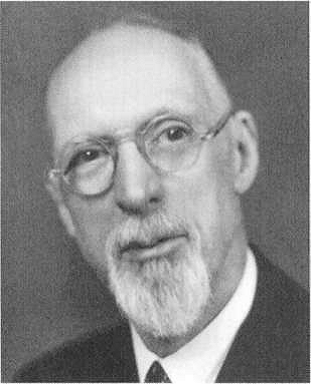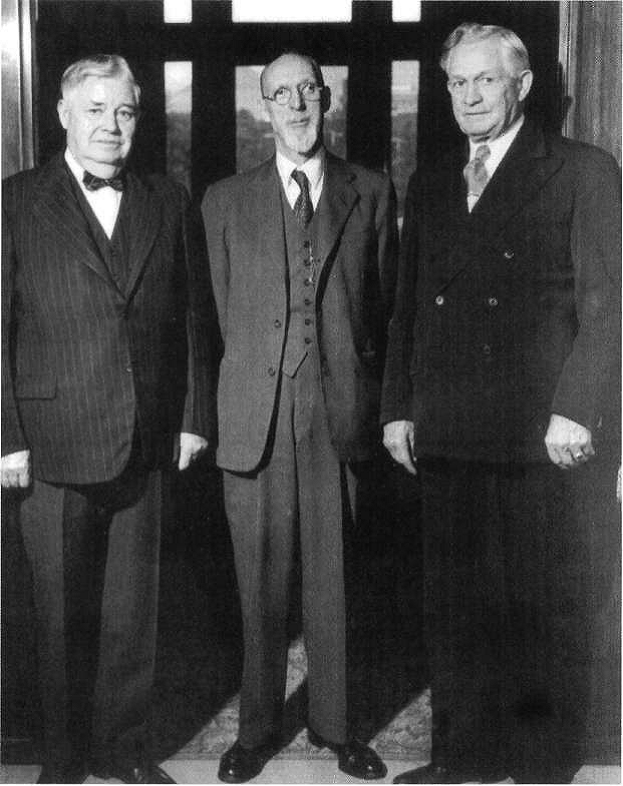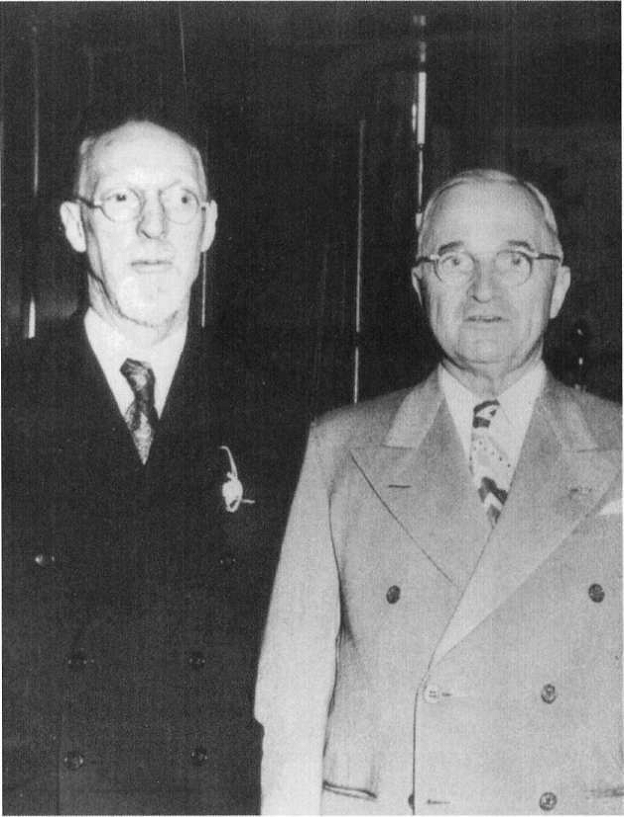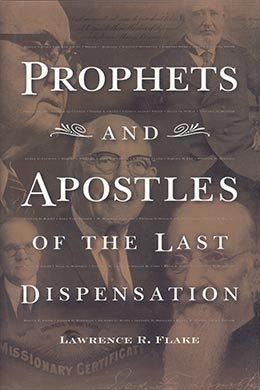George Albert Smith
Lawrence R. Flake, Prophets and Apostles of the Last Dispensation (Provo, UT: Religious Studies Center, Brigham Young University, 2001) 75–83.

Born: 4 April 1870, Salt Lake City, Utah
Quorum of the Twelve Apostles: 8 October 1903 (age 33)
President of the Quorum of the Twelve: 1 July 1943
President of the Church: 21 May 1945 (age 75)
Died: 4 April 1951 (age 81), Salt Lake City, Utah
When George Albert Smith, son of John Henry and Sarah Farr Smith, entered the world on 4 April 1870, he inherited a rich spiritual legacy. His great-grandfather was John Smith, a patriarch to the Church and the brother of Joseph Smith Sr. His grandfather was George A. Smith, an apostle ordained at the age of twenty-one and a counselor to President Brigham Young; and his own father, John Henry Smith, was also a member of the Quorum of the Twelve and a counselor to President Joseph F. Smith. George Albert greatly revered his father, often stating that he had never known a greater man.
Though only seven years old when Brigham Young died, Elder Smith could recall the impressive experience of visiting him on an errand for his mother. Dressed in a black velvet suit, little George Albert walked alone to President Young’s office. The gatekeeper refused entrance to the little visitor, but President Young noticed the boy and invited him in. Brother Smith wrote: “President Young took me by the hand and led me into his office, sat down at his desk and lifted me up on his knee and put his arm around me. In the kindest way one could imagine, he said, ‘What do you want of President Young?’ Just think of it! He was President of a great Church and Governor of a Territory, and with all the duties he had to perform, yet I as a little boy was received with as much dignity, and kindness as if I had come as a governor from an adjoining state.” [1]
When only thirteen years of age, George Albert obtained employment at ZCMI putting rivets in overalls. He persevered long hours for a meager wage of two dollars and fifty cents per week, a sum that, though small, was sorely needed in the Smith family of fifteen children. Fortunately he had an opportunity to obtain some schooling at the University of Utah and at Brigham Young Academy, where he came under the inspired tutelage of Karl G. Maeser. Following this schooling, he was employed for a while on a surveying crew for a railroad. Working out of doors in the excessive heat and glaring sun permanently damaged his eyesight; he also had an uncentered left eye. “During his life President George Albert Smith coped with his handicap, coped with it in his reading, in his constant daily vision, and in the initial glances of others. But rather than lament his own handicap, he turned himself outward to others and won their undying love and friendship.” [2]
One week after his marriage to his cherished childhood sweetheart, Emily Woodruff, granddaughter of President Wilford Woodruff, George accepted a call to the Southern States Mission. Following about four months of proselytizing, he was assigned to work in the mission office, and at that time his wife was privileged to join him. [3]
He had many harrowing experiences in the mission field, including one in which his talent for singing served him well. One day a bitter enemy of Mormonism saw the missionaries meeting in a cabin. He quickly gathered a mob of ruffians with the intention of lynching the elders. As the armed men approached the cabin, they heard sweet melodious voices singing the song “Do What Is Right.” The leader of the mob stopped, removed his hat, and dismounted. He told the men assembled that a mistake had been made: “Wicked men could not sing like that.” Elder Smith’s life was spared, and not long afterward this former mob leader became a member of the Church.
Another time when Elder Smith was touring with his mission president, J. Golden Kimball, the cabin in which they were sleeping was surrounded by a group of angry men using foul language. They ordered the missionaries to come out. President Kimball began to dress and asked if Elder Smith was planning to join him. The young missionary reported, “I told him no, I was going to stay in bed, that I was sure the Lord would take care of us.” The mob soon divided into four groups and began shooting at the cabin from all sides. President Smith said, “Splinters were flying over our heads in every direction. . . . I felt absolutely no terror. I was very calm as I lay there, experiencing one of the most horrible events of my life, but I was sure that as long as I was preaching the word of God and following his teachings that the Lord would protect me, and he did.” [4]
 First Presidency, 1945–51. Left to right: J. Reuben Clark Jr., President George Albert Smith, and David O. McKay
First Presidency, 1945–51. Left to right: J. Reuben Clark Jr., President George Albert Smith, and David O. McKay
In 1898 George Albert Smith received one of the first major federal appointments given to a Latter-day Saint in the new state of Utah as a result of his efforts in the presidential campaign of William McKinley. He was given a position as Receiver of the Land Office of Utah, a post which was renewed by President Theodore Roosevelt without solicitation. In 1903, at the age of thirty-three, Elder Smith was called to the Quorum of the Twelve. Holding this position in the Church was the fulfillment of a prophecy given in a blessing he received at the age of fourteen, which said, “Thou shalt become a mighty Apostle in the Church and kingdom of God upon the earth, for none of thy father’s family shall have more power with God than thou shalt have.” [5] As a member of the Twelve, he became European Mission president in 1919, general superintendent of the Young Men’s Mutual Improvement Association from 1921 to 1935, and president of the Quorum of the Twelve in 1943. He also made many tours to distant mission fields, including the South Pacific. George Albert Smith and his father, John Henry Smith, had the distinction of being the only father and son to serve simultaneously in the Quorum of the Twelve, which they did from 1903 until 1911.
For four years, beginning in 1909, President Smith suffered a severe illness and was unable to carry on his duties as a general authority. He moved to California to convalesce and later to St. George, Utah. While in this weakened condition, he had a memorable dream. He saw himself in a wooded countryside being approached by a large man whom he recognized as the grandfather whose name he had been given. Grandfather Smith stopped and looked his grandson in the eye, saying, “I would like to know what you have done with my name.” President Smith related: “Everything I had ever done passed before me as though it were a flying picture on a screen. . . . I smiled and looked at my grandfather and said: ‘I have never done anything with your name of which you need be ashamed.’ He stepped forward and took me in his arms, and as he did so, I became conscious again of my earthly surroundings. My pillow was . . . wet with tears of gratitude that I could answer unashamed.” [6]
On 21 May 1945 George Albert Smith became the eighth president of the Church. During his administration, the missions that had been closed in Europe as a result of World War II were reopened. President Smith visited President Harry S. Truman with a request for permission to send carloads of goods to the war-impoverished Saints in Europe. He recounted the events of this interview: “[President Truman] smiled and looked at me, and said: ‘Well, what do you want to ship [merchandise] over there for? Their money isn’t any good.’ I said: ‘We don’t want their money.’ He looked at me and asked: ‘You don’t mean you are going to give it to them?’ I said: ‘Of course, we would give it to them. They are our brothers and sisters and are in distress. God has blessed us with a surplus, and we will be glad to send it if we have the cooperation of the government.’” [7]
President Truman inquired as to the length of time it would take to accumulate these great quantities of goods, to which President Smith replied: “Mr. President, while the administration at Washington were advising the destroying of food, we were building elevators and filling them with grain, and increasing our flocks and our herds, and now what we need is the cars and the ships in order to send considerable food, clothing and bedding to the people of Europe who are in distress. We have an organization in the Church that has over two thousand homemade quilts ready.” [8]
 President George Albert Smith with U.S. President Harry S. Truman
President George Albert Smith with U.S. President Harry S. Truman
The love and sympathy President Smith felt for the suffering victims of the war are illustrated in an incident which occurred at Welfare Square. His secretary, Joseph Anderson, recalled: “As he stood before the open boxes where clothing was being gathered to be shipped to Europe, [President Smith] removed his coat and laid it on one of the piles. Despite the protests of his associates, he insisted and returned to the Church offices without his coat.” [9]
Possessed of a great interest in pioneer history, President Smith was a founder of the Utah Trails and Landmarks Association. During the pioneer centennial in 1947, the prophet made the same journey by automobile that the Saints had made one hundred years before. When he arrived in Emigration Canyon on 24 July, fifty thousand Utahns had gathered there to greet him and watch him lay the cornerstone for the beautiful This Is the Place Monument. The story of these noble pioneers, among which were his own ancestors, greatly moved President Smith. He spoke of them often: “The scene of our pioneers toiling across the plains touched my heart, and tears dimmed my eyes as I thought of them under the burning sun’s rays and in many cases in the snow; and remembering that my own father was born on the way, I asked myself: Am I living to be worthy of the sacrifices that were made by men and women such as these?” [10]
One of President Smith’s most outstanding characteristics was his unqualified love for his fellowmen. Once while his car was parked in downtown Salt Lake City, a blanket was stolen from it. That night he wrote, “If I thought the man who took it really needed it I would have presented it to him and he would not have been a thief.” [11] George Albert Smith’s philosophy was embodied in a beautiful creed he wrote and lived, part of which reads, “I would be a friend to the friendless and find joy in ministering to the needs of the poor. . . . I would seek out the erring one and try to win him back to a righteous and a happy life. I would not seek to force people to live up to my ideals but rather love them into doing the thing that is right. . . . I would not knowingly wound the feelings of any, not even one who may have wronged me, but would seek to do him good and make him my friend. . . . I would not be an enemy to any living soul.” [12]
When the long and productive life of George Albert Smith ended, his loved ones and the Church took comfort from another promise in his patriarchal blessing: “And thou shalt remain upon the earth until thou art satisfied with life.” [13] He died peacefully on 4 April 1951, his eighty-first birthday. Matthew Cowley, a member of the Quorum of the Twelve, spoke at his funeral and voiced the feelings of all who knew President George Albert Smith: “God attracts the godly, and I am sure that the shortest journey this man of God ever made in all of his travels has been the journey which he has just taken.” [14]
Notes
[1] “George Albert Smith: On Reaching Out to Others,” New Era, January 1972, 51.
[2] “George Albert Smith,” 55.
[3] Francis M. Gibbons, George Albert Smith: Kind and Caring Christian, Prophet of God (Salt Lake City: Deseret Book, 1990), 24–25.
[4] The Primary Association General Board, and the Deseret Sunday School Union Board, comp., A Story to Tell, for Teachers, Parents, and Children (Independence, MO: Zion’s Printing & Publishing, 1945), 156.
[5] Doyle L. Green, “Tributes Paid President George Albert Smith,” Improvement Era, June 1951, 404–5.
[6] George Albert Smith, “Your Good Name,” Improvement Era, March 1947, 139.
[7] George Albert Smith, “The Growth of the Church,” Improvement Era, November 1947, 703.
[8] Smith, “The Growth of the Church,” 803.
[9] Joseph Anderson, Prophets I Have Known (Salt Lake City: Deseret Book, 1973), 103.
[10] Conference Report, April 1930, 68.
[11] Preston Nibley, The Presidents of the Church (Salt Lake City: Deseret Book, 1959), 358.
[12] Bryant S. Hinckley, “Superintendent George Albert Smith,” Improvement Era, March 1932, 295.
[13] Green, “Tributes Paid,” 405.
[14] Green, “Tributes Paid,” 405.
